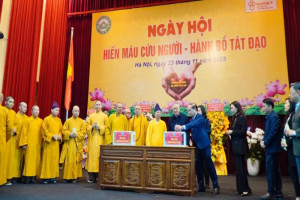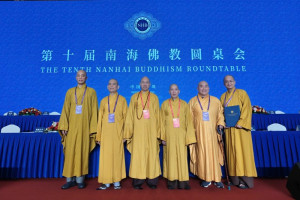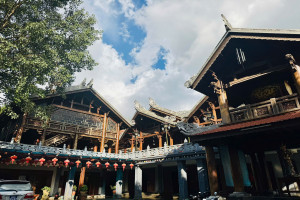
Mother Mary Angelica of the Annunciation, a cloistered Franciscan nun who founded the largest Roman Catholic television network in the country, and used it unstintingly to criticize liberalizing trends in the Catholic Church, died on Sunday. She was 92.
The cause was complications of a stroke, according to a statement posted online by the Eternal Word Television Network, the media organization she founded.
Mother Angelica began the Eternal Word Television Network in 1981 with $200, a makeshift studio in a monastery’s garage in Irondale, Ala., and one on-air personality, herself.
By the time she retired in 2001 after a series of debilitating strokes, her homespun half-hour program of advice and commentary, “Mother Angelica Live,” was the anchor of a 24-hour Catholic programming network reaching over 100 million homes in the United States, South America, Africa and Europe.
A 1995 profile in Time magazine called her “an improbable superstar of religious broadcasting and arguably the most influential Roman Catholic woman in America.”
Archbishop Charles Chaput of Philadelphia, a member of the network’s board of governors, said in its statement that Mother Angelica “succeeded at a task the nation’s bishops themselves couldn’t achieve.”
Mother Angelica’s television persona, which survives in network reruns and perennially popular YouTube clips, was that of a shrewd yet grandmotherly nun from a seemingly bygone era.
Her face framed in full nun’s habit and filling the screen almost edge to edge, she answered viewers’ questions at a leisurely, sigh-punctuated pace that accommodated the long digressions that became her trademark.
She wisecracked about nuns, once describing the ones who taught her in parochial school as “the meanest people on God’s earth.” She dispensed religious opinions sometimes at odds with Vatican policy. She lectured teenagers on fornication, bishops on theology. And at her most passionate, she attacked feminists and other liberals she saw as undermining the authority of the church.
It was a television style that made her irresistible to traditionalist Catholics, who never warmed to American church leaders’ efforts, after the Second Vatican Council of 1962-65, to demystify rituals and nudge congregations toward greater social engagement. That audience contributed generously to her enterprise, donating what The National Catholic Reporter estimated at $25 million annually in 1994.
Mother Angelica’s outspokenness on church issues — her pet peeves were gender-neutral language in the liturgy and a change allowing girls to become altar servers — made her both friends and enemies among the Catholic faithful.
It also brought her into conflict with members of the church hierarchy.
In 1993, when a World Youth Day event in Denver featured a woman playing the role of Jesus Christ in a Passion play, she called it “blasphemous,” and delivered a litany of complaints during her show about what she called the “ungodly” influence that liberals were having on the church.
“I am so tired of you, liberal church in America,” she said. “I resent you pushing your anti-Catholic, ungodly ways upon the masses of this country.”
Archbishop Rembert Weakland of Milwaukee, a prelate identified at the time with the church’s progressive wing, called her remarks “disgraceful, un-Christian, offensive and divisive.” The administrative body of American bishops, then known as the National Conference of Catholic Bishops, asked that the segment be pulled from the network’s lineup of reruns. Mother Angelica refused.
A more significant clash occurred in 1997, when Mother Angelica criticized Cardinal Roger M. Mahony of Los Angeles for proposing changes in the sacrament of holy communion that she viewed as a breach of core church doctrine.
“I’m afraid my obedience in that diocese would be absolutely zero,” she said. “And I hope everybody else’s in that diocese is zero.”
Cardinal Mahony demanded an apology and a retraction of her call for disobedience. He received a grudging apology, which Mother Angelica then obscured with a long on-air explication of her complaint. At the cardinal’s request, the Vatican began an inquiry into her work. No disciplinary action was taken.
In 2009, Pope Benedict XVI awarded Mother Angelica the Cross of Honor for distinguished service. It is the highest award a pope can give to a member of the laity, the term by which the church defines everyone except ordained priests.
Mother Angelica was born Rita Antoinette Rizzo on April 20, 1923, in Canton, Ohio, the only child of John and Mae Rizzo. Her father abandoned the family when she was 5, and she spent much of her early life plagued by an array of stomach ailments.
In 1943, she claimed to have been cured by a Catholic faith healer, signaling the beginning of her interest in a religious vocation, according to a 2007 biography written by Mr. Arroyo, “Mother Angelica: The Remarkable Story of a Nun, Her Nerve, and a Network of Miracles.”
After she took vows as a member of the Poor Clares of Perpetual Adoration, a contemplative order of Franciscan nuns in Canton, another physical ailment — a spinal injury suffered in a fall, followed by two years of chronic pain — led her to promise to build a new monastery if cured. Her prayers answered, she set off in 1962 with four other sisters of her order to start Our Lady of the Angels Monastery in Irondale, a place with almost no Catholics.
There, Mother Angelica began writing booklets and recording audiocassettes to introduce Catholicism to her new neighbors. When a local television station gave her a half-hour of airtime, her on-camera charisma attracted Pat Robertson’s Christian Broadcasting Network, which began airing her show on its satellite network.
In an interview with The New York Times in 1989, Mother Angelica described how a visit to a television studio in Chicago ignited her entrepreneurial drive, and led to the birth of her worldwide enterprise.
“I walked in, and it was just a little studio, and I remember standing in the doorway and thinking, it doesn’t take much to reach the masses,” she said.
“I just stood there and said to the Lord, ‘Lord, I’ve got to have one of these.’”
Source: http://www.nytimes.com/




